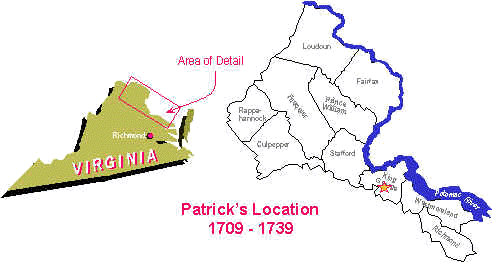
Patrick Hamrick
Family Patriarch
PATRICK'S LIFE
October 10, 1709
Sem Cox leased 100 acres of land to Robert Ingles. Both men were planters of St. Mary’s Parish in Richmond County. The land was in Stafford County upon the lines of William Bumberry & Lewis Griffin and upon a p’cell of Land formerly let by the said Sem Coxe to one William Browne and like wife. The lease, in part, states: and from and after his [Robert Ingles’] dicease to the use and behoof of Sara the Wife of the said Robert Ingles for and during the term of her widowhood And from and after her Intermarriage or dicease To the use and behoof of Margrett Ingles Spinster Daughter of the said Robert Ingles for and during the terme of her natural life & after her dicease To the use and behoof of the heirs of the body of the said Margrett lawfully to be begotten forever and for want of such issue to the use and behoof of the right and next heirs of the said Robert Ingles forever more. (Richmond County Deed Book 5 1708 – 1711. pp. 157 - 159.)
Patrick married Margaret Ingles sometime subsequent to this lease and by 1726, as a result of the marriage, gained ownership of this property. REF: see entries December 17, 1726 a through December 17, 1726 c.
In 1709, St. Mary’s Parish was located in the western part of Richmond County and extended south across the Rappahannock River into Essex County. Subsequently, in 1713, the portion on the north side of the river, in Richmond County, became Hanover Parish. (Charles Francis Cocke. Parish Lines Diocese of Virginia. Richmond: The Virginia State Library, 1967. pp. 111 - 112.)
Ensuing facts and investigation reveal that this property was actually in the Dogue Run area, located within the portion of St. Mary’s Parish that became Hanover Parish, which, in turn, became part of King George county when it was formed in 1721. The property was, however, very near the Stafford county line, which seemed to have an extremely fuzzy border with King George county.
Patrick’s marriage to Margaret Ingles along with subsequent events make it evident that he migrated to this area after his indentured servitude, probably by the time of this deed. The area is roughly 35 miles northwest of William Hammock’s property in the Totaskey Creek region of Richmond County. Tobacco farming was very hard on the land, which kept planters moving to the west. Landless individuals (like Patrick after he was freed from servitude) commonly migrated to the frontier where plantations were forming and work was more plentiful. (Allan Kulikoff. Tobacco and Slaves: The Development of Southern Culture in the Chesapeake 1680 – 1800. Chapel Hill, NC: The University of North Carolina Press, 1986. pp. 64 – 65.)
The language in this deed leads one to believe that Sem Cox was probably Margaret’s grandfather (Robert Ingles’ father-in-law and Sara Ingles’ father). It is what was referred to as a deed of entailment—a common method of assuring that a parcel of land stayed in the family. If they were not related, Sem Cox would have no apparent reason to spell out the intricacies of successive ownership that are detailed in the deed. His Last Will and Testament was dated about one year after this. (Richmond County Wills & Inventories 1709 – 1717. pp. 28 - 30.) The will is very difficult to read but it appears to accomplish a similar succession of ownership for other lands owned by Sem Cox. In this instance, to another daughter Ann and her minor grandson Joseph Downing. It seems logical that with this deed to Robert Ingles, Sarah, and Margaret, he is providing for them as heirs.
At this time in history, the term "spinster" was commonly used to refer to any unmarried woman who was considered old enough to be married. (Paul Drake. What Did They Mean By That?: A Dictionary of Historical Terms for Genealogists. Bowie, MD: Heritage Books, Inc., 1994. p. 202.) Women usually married sometime between their sixteenth and nineteenth birthdays. (Thad W. Tate and David L. Ammerman. The Chesapeake in the Seventeenth Century: Essays on Anglo-American Society. Chapel Hill, NC: The University of North Carolina Press, 1979. p.128. AND Albert Alan Rogers. Family Life in Eighteenth Century Virginia. Charlottesville, VA: University of Virginia, 1939. pp. 83, 111, 124, 165, & 260-261.) Therefore, Margaret was probably at least 16 years old and was most likely born sometime between 1690 and 1693.
